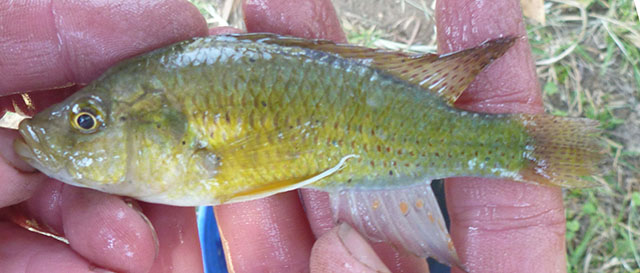|
Dorsal spines (total): 14-16; Dorsal soft rays (total): 9-10; Anal spines: 3-3; Anal soft rays: 8-10; Vertebrae: 28-30. Diagnosis: A species of Astatotilapia with a relatively slender body, its depth 32-37% of standard length; snout pointed; mouth large, oblique, lower jaw 37-45% of head length; caudal fin well rounded, slender, maximum width when extended 75-80% of its length; caudal peduncle longer than deep, its length/depth 1.10-1.44; chest scales relatively small, 12-14 in mid-ventral line between the row's origin on the isthmus and its termination between pelvic fins; colouration of breeding males distinctive with a well-marked series of maroon red spots along flanks, in parallel rows along scale rows except rows on and above upper lateral line (Ref. 49182). Description: Dorsal head and snout profile with a slight interorbital concavity and otherwise straight, but with premaxillary pedicels often forming a prominent step in larger individuals; angle of dorsal head profile 30-35° to the horizontal (Ref. 49182). Widest breadth of snout equal to or slightly greater than its length; posterior maxillary tip extending to at least the vertical from anterior orbital margin; lower jaw protruding slightly in advance of upper when closed (Ref. 49182). Gill-rakers short, 8-10, rarely a reduced 11th, on lower limb of first arch, the upper (posterior) 3-4 broad, bifid or thickly T-shaped in older fishes, the lower (anterior) 2-3 reduced (Ref. 49182). Scales ctenoid except on nape and chest where they are cycloid; lateral line interrupted, the last 2-6 scales of the upper lateral-line series separated from dorsal-fin base by 1-1.5 scales; thoracic scales smaller than those on nape and belly, 12-14 scales in mod-ventral line between the row's origin on isthmus and its termination between pelvic fins; 5-8 scales between anterior insertions of pectoral and pelvic fin bases; 5-6 between dorsal-fin origin and upper lateral line; cheek with 3-5 series of scales; scales in longitudinal series 28-32 (Ref. 49182). Dorsal fin with 14-16 spines and 9-10 soft rays; anal fin with 3 spines and 8-10 soft rays; first pelvic ray produced, reaching to vent in small fishes and as far as third anal spine in larger individuals; pectoral fin shorter than head; caudal fin distinctly rounded and relatively elongate, its maximum width when extended 75-80% of its length (Ref. 49182). Jaws with single outer row of larger teeth, 1-3 irregular rows of considerably smaller inner teeth, mainly in 2 rows; up to 75 mm standard length most outer teeth in both jaws are laterally compressed, bicuspid with one cusp considerably smaller and diminishing and becoming rounded with increasing size of fish; above this size the minor cusp disappears into a rounded shoulder with the major cusp becoming more pointed, such unicuspid teeth occurring mainly in the lower jaw and posterolaterally in the upper; in fish larger than 86 mm standard length the teeth tend to lose the compressed base and become caniniform and relatively slender; tooth number variable, becoming more numerous with increased size; fish smaller than 45 mm standard length with about 40 teeth in upper jaw, larger fish with up to 54 teeth in the outer series; inner teeth small and mostly tricuspid, the minor cusps very small and equal in size (Ref. 49182). Lower pharyngeal bone of the usual pattern in Astatotilapia with the teeth in the median rows somewhat enlarged and stout, cuspidate in juveniles but becoming conical and sub-molariform in adults; pharyngeal bone is comparatively slender and with longer blade-like portion than in other species of the genus (Ref. 49182).Vertebrae, excluding the fused PU and U elements 28-30, comprising 12-13 precaudal and 15-16 caudal vertebrae (Ref. 49182). Colouration: Preserved specimens with ground colour evenly brown in both sexes, lighter below; usually plain but rarely with faint dark transverse bars and faint longitudinal line midway along posterior third of body to caudal peduncle; well-marked series of dark brown spots along flanks, in parallel lines along scale rows except above upper lateral line, the location of each spot is such that it appears to lie at the free margins of the scale overlying it; a broad sub-lachrymal stripe present; posterior spinous and entire soft part of dorsal fin spotted; caudal fin spotted, occasionally entirely so but more usually mainly in the upper half; pectoral and anal fin plain, except anal fin of males with a single or double row of 4-7 ocelli with a narrow clear surround; pelvic fins with outer half usually black, the leading edge of the first ray whitish (Ref. 49182). Live male specimens with ground colour dark brownish-green with a faint darker longitudinal stripe along flanks; posterior edges of flank scales with a thin iridescent blue border, silver-grey below; operculum with silver iridescence, a large brown patch in posterior half with a gold spot on it near dorsal edge; eye dark blue; top of head and snout dark brown; lips, especially lower, iridescent blue; rows of spots along flank scales maroon-red; dorsal and caudal fin spots reddish brown; anal ocelli light brownish-red, the surrounding anal fin yellowish-brown; pelvic fins with outer half black, first pelvic ray cream-white (Ref. 49182). |

